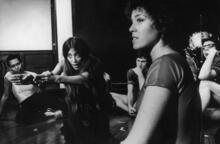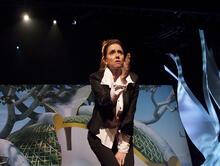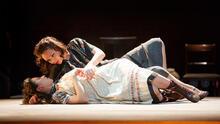Julie Taymor
Julie Taymor is an award-winning theater, opera, and film director best known for being the first woman to win a Tony Award for directing a Broadway Musical: The Lion King. After college, she spent a year studying puppetry in Eastern Europe, Indonesia, and Japan and spent four years in Java. Returning to the United States, her career took off quickly. Her theater and opera credits include: The Haggadah (1980), Liberty’s Taken (1985), The Tempest (1986), The Magic Flute (1993), The Flying Dutchman (1995), The Lion King (1997), Grounded (2015), M. Butterfly (2017). Her film credits include: Titus (1999), Frida (2002). Across the Universe (2007), and The Glorias (2020). Taymor has received dozens of awards in addition to her Tony, including a Guggenheim Fellowship and a MacArthur Fellowship.
In her 2011 TED talk, noted theater, opera, and film director Julie Taymor describes her artistic process. She explains:
I start with the notion of the ideograph. An ideograph is like a brush painting, a Japanese brush painting. Three strokes, you get the whole bamboo forest. I go to the concept of The Lion King and I say, what is the essence of it? What is the abstraction? If I were to reduce this entire story into one image, what would it be? The circle. The circle. It’s so obvious. The circle of life. The circle of Mufasa’s mask. The circle that, when we come to Act II and there’s a drought, how do you express drought? It’s a circle of silk on the floor that disappears into the hole in the stage floor. The circle of life comes in the wheels of the gazelles that leap. And you see the mechanics. And being a theatre person, what I know and love about the theatre is that when the audience comes in and they suspend their disbelief...I love the apparent truth of theatre. I love that people are willing to fill in the blanks. The audience is willing to say, Oh, I know that’s not a real sun. You took pieces of sticks. You added silk to the bottom. You suspended these pieces. You let it fall flat on the floor. And as it rises with the strings, I see that it’s a sun. But the beauty of it is that it’s just silk and sticks. (“Julie Taymor: Spider-man” 2011)
Taymor’s gift is her ability to take silk, sticks, and string and create magical worlds that transport audiences to faraway places. To imaginary realms. To other worlds. Taymor’s gift is that she makes magic happen.
Early Life
Julie Taymor was born on December 15, 1952, the youngest of the four daughters of Betty Bernstein Taymor, an activist in Democratic politics, and Melvin Taymor (d. 1997), a gynecologist. Raised in a secular Jewish household in Newton, Massachusetts, a suburb of Boston, she studied theater from age ten at the Boston Children’s Theater and, during her final year of secondary school, at the Theater Workshop of Boston, where director Julie Portman focused on experimental ensemble creation. During high school, Taymor also spent a summer traveling in Sri Lanka and India, getting her first taste of what would later become a serious involvement in traditional Asian theater.
Following high school, Taymor spent a year in Paris studying at L’Écôle de Mime Jacques LeCoq. She graduated from Oberlin College in Ohio in June 1974. While attending Oberlin, she earned credits away from the college, apprenticing with experimental theater companies in New York and taking anthropology classes at Columbia University. Her main focus at Oberlin was a theater group run by Herbert Blau, which developed performance projects through ensemble workshops. Taymor credits Blau with helping to shape much of her ongoing approach to performance.
Early Career
With a one-year Watson traveling fellowship to study puppetry in Eastern Europe, Indonesia, and Japan, Taymor headed for Java after college. There she became involved with W. S. Rendra, one of Indonesia’s most respected (and controversial) directors and playwrights. He encouraged her to direct. She spent four years in Indonesia, living in Yogjakarta and then Bali and ultimately creating her own theater company, Theater Loh, with Indonesian and Western actors. She conceived, directed, and designed Way of Snow, a trilogy about cultural dislocation and madness, using masked actors, three-dimensional rod-puppets, and shadow puppets—some made from the traditional carved water-buffalo hide, others from modern Plexiglass. Taymor’s troupe performed Way of Snow on the Islands of Java and Bali between 1974 and 1975. Her next piece, Tirae, was also an ensemble creation, this time for masked and unmasked actors. After returning to the United States, she managed to remount both pieces in New York in 1980 and 1981.
From here, Taymor’s career took off quickly. She designed costumes, masks, puppets, and sometimes sets for various shows over the next four years: from 1980 to1982 The The "guide" to the Passover seder containing the Biblical and Talmudic texts read at the seder, as well as its traditional regimen of ritual performances.Haggadah, conceived, composed and directed by Elizabeth Swados, at the New York Shakespeare Festival; in 1981 Black Elk Lives, written by Christopher Sergel, based on the novel Black Elk Speaks, directed by Tom Brennan, at the Entermedia Theatre, New York City; in 1982 Savages by Christopher Hampton, directed by Jackson Phippin, at Center Stage, Baltimore, Maryland; and in 1984 The King Stag by Carlo Gozzi, directed by Andrei Serban, at the American Repertory Theatre, Cambridge, Massachusetts.
At the same time Taymor continued to develop her own projects, adapting non-theatrical materials, usually in collaboration with writers and often with composer Elliot Goldenthal. Her first version of The Transposed Heads, which she adapted with Sydney Goldfarb, played at the Ark Theater in New York in 1984. Two years later a new, totally restaged version, with music by Goldenthal, played at the American Music Theatre Festival in Philadelphia, Pennsylvania, and at Lincoln Center in New York City.
In 1985 Taymor directed Liberty’s Taken, a picaresque musical about the American revolution, on which she had been working for four years. She wrote the book with David Suehsdorf, an old colleague from Herb Blau’s Oberlin Group, Goldenthal wrote the music, and G. W. Mercier—who would also work with Taymor on subsequent projects—collaborated on the design. The show had just a few performances at an outdoor theater in Ipswich, Massachusetts, with hordes of mosquitoes and biting green-head flies plaguing performers and spectators alike.
Taymor’s most important original project during the 1980s was Juan Darién: A Carnival Mass, which she co-wrote with Goldenthal, based on a short story by Horacio Quiroga. Taymor directed, as well as creating the puppets and masks. She collaborated with G. W. Mercier on costumes. This work, about a baby jaguar turned into a human by human love but then driven back to savagery by human cruelty, was Taymor’s first foray into Latin American “magic realism.” Juan was played successively by small puppets (first a jaguar, then a baby) controlled by one person, then by a Bunraku-type puppet with three handlers, and finally by a live child actor. The show, which premiered at St. Clements Church in New York in 1988, was revived for performances in New York in 1990 and 1996 and for tours to Edinburgh, Canada, France, and Israel in 1990–1991.
Meanwhile, Jeffrey Horowitz, the artistic director of Theater for a New Audience, invited Taymor to direct Shakespeare. She directed The Tempest in 1986, The Taming of the Shrew in 1988, and Titus Andronicus in 1994, all at Theater for a New Audience and all with music by Goldenthal. Shrew used no masks or puppets, and The Tempest and Titus used them sparingly, for Ariel, Caliban, and the shipwreck, and for a nightmare sequence of the rape and mutilation of Lavinia. Titus, with sets, costumes, and props covering Western culture from Rome to the present and with its circus-like presentation of the gore, was perhaps Taymor’s darkest and strongest work to date. In a much-enlarged form, it became the basis of her first feature film. She later directed and co-designed Carlo Gozzi’s commedia play The Green Bird for Theater for a New Audience in 1996.
By this time, Taymor had already made her first two films. Fool’s Fire (1992) was her own adaptation of Edgar Allan Poe’s short story “Hop-Frog.” It played at the Sundance Film Festival and on PBS (the Public Broadcasting Service). In 1992 she directed a film of a production she directed of Stravinsky’s opera Oedipus Rex, conducted by Seiji Ozawa, at the Saito Kinen Festival in Japan.
Oedipus Rex was the first of several major opera productions that Taymor directed. In 1993 she directed Mozart’s The Magic Flute at Maggio Musicale, in Florence, Italy, with Zubin Mehta conducting. Michael Curry collaborated with Taymor on the masks and puppets. Her production of the Richard Strauss opera Salome played at the Passionstheater, in Oberammergau, Germany, and at the Kirov Opera’s Mariinsky theater in 1995. Her direction of Wagner’s The Flying Dutchman opened in 1995 at the Los Angeles Opera and was revived three years later at the Houston Grand Opera. It played at the New Israel Opera company in Tel Aviv in 1998. These opera productions were all extremely elaborate. Oedipus played on an enormous, eye-shaped wooden stage, with a pool of water below and rain falling upstage at the end. The set for The Magic Flute was such an engineering challenge that it had to be built by a bridge-building company.
Broadway Debut
It was Taymor’s 1997 staging of Walt Disney’s The Lion King that made her a household name and the first woman to win a Tony for directing a musical. After the success of the stage adaptation of Beauty and the Beast, Michael Eisner, then CEO of the Walt Disney Corporation, determined that The Lion King would be the next Disney property on Broadway. Thomas Schumacher, the head of Disney’s theater division immediately thought of Taymor to take on the challenge. Taymor partnered with South African composer Lebo Morake (Lebo M.) to expand the score and further developed the female characters. The final product was lauded by critic John Lahr as the “ultimate business art” because of the quality of its artistry and its potential profitability. Taymor was able to meld her own unique style of storytelling with the Disney film to create a magical theatrical experience unlike anything seen on Broadway before.
After the success of The Lion King, Taymor turned her talents to feature films. Her 1999 screen adaptation Titus starred Anthony Hopkins and Jessica Lange. In 2002 she returned to the magic realism of Latin America for Frida, a film about Frida Kahlo starring Salma Hayek as Frida and Alfred Molina as Diego Rivera. In 2007, Taymor directed Across the Universe, another foray into magical realism, this time set to the music of The Beatles. Taymor again returned to features with the 2020 Gloria Steinem biopic The Glorias, which she co-wrote with playwright Sarah Ruhl.
Despite her jump to the screen, Taymor continued to work in the world of opera and theater. She directed a new production of The Magic Flute for the 2004–2005 season at the Metropolitan Opera in New York and an original opera, Grendel, a long-term project she created with Goldenthal, for the 2006 season of the Los Angeles Opera and then at the Lincoln Center Festival in New York.
Taymor’s next Broadway outing was 2011’s enormous comic book musical Spider-Man Turn Off The Dark. The show, the most expensive Broadway production ever mounted with a $75 million price tag, was riddled with problems. These issues, along with rumors of behind-the-scenes clashes between its creators, led to Taymor being let go from the production during previews. When the production finally opened, Taymor’s stamp could still be seen on several elements of the production, but much of her vision (and a cohesive vision in general) was lost. The production closed in 2014 having lost $60 million.
After the disappointment of Spider-Man, Taymor turned away from Broadway, choosing instead to work in smaller venues where she would have more creative freedom. In 2013, she returned to Shakespeare, helming a production of A Midsummer Night’s Dream at Theatre for a New Audience. She also directed an imaginative production of George Brandt’s one-woman play, Grounded, at The Public Theatre in 2015. Taymor again returned to Broadway in 2017 with a production of David Henry Hwang’s M. Butterfly.
Awards
Over the years, Taymor’s work has garnered practically every award in American theater. She received Villager Theater Awards for the sets and puppets in The Haggadah and for direction in Way of Snow; Maharam Theater Design Citations for Way of Snow and Tirae; Obie (“Off-Broadway”) Awards for Transposed Heads and Juan Darién; an Emmy award for costumes in Oedipus Rex; and the International Classical Music Award, 1994, for Oedipus Rex. For The Lion King, she received a Tony Award, Outer Critics Circle Award, Drama Desk Awards for direction, costume design, and (with Michael Curry) puppet design; Tony Awards for direction and costumes; a (British) Olivier award for costumes; and (French) Molière Awards for costumes and best musical. Her film Frida earned Academy awards for best score and best makeup.
In 1990 Taymor received both a Guggenheim Fellowship and the first Dorothy Chandler Performing Arts Award in Theater. In 1992 she was granted a MacArthur Fellowship. In 1999 the Wexner Center for the Arts in Ohio mounted a retrospective of Taymor’s work. The exhibition subsequently appeared at The National Museum of Women in the Arts (Washington D.C.) and the Field Museum (Chicago).
Behind the Scenes With Julie Taymor (PBS program for young audiences) (VHS), First Run Features, 1992.
Blumenthal, Eileen, and Julie Taymor. Julie Taymor: Playing with Fire—Theater, Opera, Film. New York: H.N. Abrams, 1995; revised, expanded edition, 1999.
Frida (VHS & DVD), dir. Julie Taymor, Miramax Home Entertainment, 2002.
The Glorias (Streaming), dir. Julie Taymor, Roadside Pictures, 2020.
"Julie Taymor: Spider-man, The Lion King, and life on the creative edge." March 2011 in Long Beach, CA. TED video, 17:39. Disney Presents The Lion King. New York: Disney Press, 1998.
Oedipus Rex (VHS), Composer Igor Stravinsky, conductor Seiji Ozawa, dir. Julie Taymor, PGD Phillips, 1994.
Osatinski, Amy. Disney Theatrical Productions: Producing Broadway Musicals the Disney Way. New York:Routledge, 2019.
Sigal, Clancy, Julie Taymor and Linda Sunshine. Frida: Bringing Frida Kahlo’s Life and Art to Film. New York: Newmarket Press, 2002.
Taymor, Julie. The Lion King: Pride Rock on Broadway. New York: Disney Editions, 1997.
Taymor, Julie, et al. Titus, The Illustrated Screenplay. New York: Newmarket Press, 2000.
Titus (VHS & DVD), dir. Julie Taymor, Twentieth Century-Fox, 2001.







